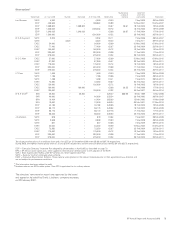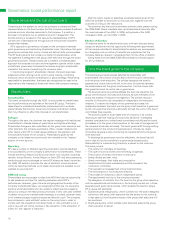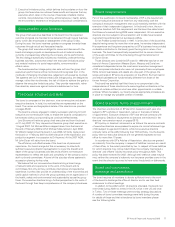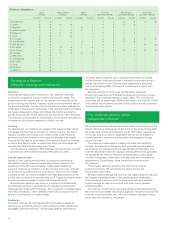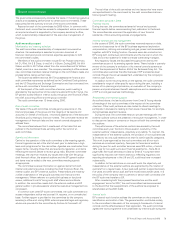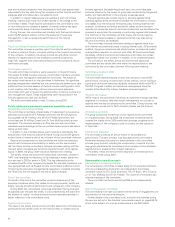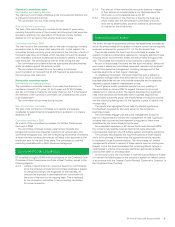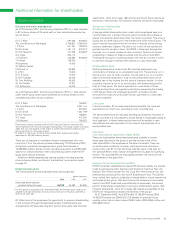BP 2006 Annual Report Download - page 87
Download and view the complete annual report
Please find page 87 of the 2006 BP annual report below. You can navigate through the pages in the report by either clicking on the pages listed below, or by using the keyword search tool below to find specific information within the annual report.
BP Annual Report and Accounts 2006 85
Legal proceedings
Save as disclosed in the following paragraphs, no member of the group
is a party to, and no property of a member of the group is subject to,
any pending legal proceedings that are significant to the group.
On 28 June 2006, the US Commodity Futures Trading Commission
(CFTC) filed a civil enforcement action in the US District Court for the
Northern District of Illinois against BP Products North America Inc. (BP
Products), a wholly owned subsidiary of BP, alleging that BP Products
manipulated the price of February 2004 TET physical propane. The CFTC
also charged BP Products with attempting to manipulate the price of
February 2004 and April 2003 TET physical propane. The CFTC is seeking
permanent injunctive relief, disgorgement, restitution and payment of
civil monetary penalties. On 28 June 2006, the US Department of Justice
filed a criminal charge against a former BP Products propane trader, who
entered a guilty plea. Proceedings in the CFTC’s civil enforcement action
have been stayed by the District Court pending the further investigation of
these matters by the Department of Justice. BP Products believes that it
has co-operated fully with the CFTC in its investigation of this matter and
is assisting the Department of Justice in its ongoing investigation. Private
class action complaints have also been filed against BP Products that
have been consolidated in the US District Court for the Northern District
of Illinois. The complaints contain allegations similar to those in the CFTC
action as well as of violations of federal and state antitrust and unfair
competition laws and state consumer protection statutes and unjust
enrichment. The complaints seek actual and punitive damages and
injunctive relief.
The CFTC is currently investigating various aspects of BP Products’
crude oil trading and storage activities in the US since 2003 and has made
various formal and informal requests for information. BP has provided,
and continues to provide, responsive data and other information to these
requests. The CFTC is also conducting an investigation into BP Products’
trading of unleaded gasoline futures contracts on 31 October 2002.
The CFTC staff notified BP on 21 November 2006 that they intend to
recommend to the CFTC that a civil enforcement action be brought
against BP Corporation North America Inc. alleging violations of Sections
6(c), 6(d) and 9(a)(2) of the Commodity Exchange Act in connection with
its trading of unleaded gasoline futures contracts on 31 October 2002.
BP has provided, and continues to provide, responsive documents and
witness testimony. The US Attorney for the Northern District of Illinois is
also conducting an investigation into BP Products’ trading of unleaded
gasoline futures contracts on 31 October 2002.
On 23 March 2005, an explosion and fire occurred in the isomerization
unit of BP Products’ Texas City refinery as the unit was coming out
of planned maintenance. Fifteen workers died in the incident and
many others were injured. BP Products has reached more than 1,000
settlements in respect of all the fatalities and many of the personal injury
claims arising from the incident. Trials have been scheduled for a number
of unresolved claims in mid-2007, although to date all claims scheduled
for trial have been resolved in advance of trial. The US Occupational
Safety and Health Administration (OSHA), the US Chemical Safety and
Hazard Investigation Board (CSB), the US Environmental Protection
Agency and the Texas Commission on Environmental Quality, among
other agencies, have conducted or are conducting investigations. At the
conclusion of their investigation, OSHA issued citations that BP Products
agreed not to contest. BP Products settled that matter with OSHA on
22 September 2005, paying a $21.4 million penalty and undertaking a
number of corrective actions designed to make the refinery safer.
OSHA referred the matter to the US Department of Justice for criminal
investigation, and the Department of Justice has opened an investigation.
At the recommendation of the CSB, BP appointed an independent safety
panel, the BP US Refineries Independent Safety Review Panel, under
the chairmanship of former US Secretary of State James A Baker, III.
See Report of the BP US Refineries Safety Review Panel on page 29
for a discussion of the Baker Panel’s report, which was published on
16 January 2007. Other government legal actions related to this matter
are pending.
Shareholder derivative lawsuits have been filed in US federal and state
courts against the directors of the company and others, nominally the
company and certain US subsidiaries following the events relating to,
inter alia, Prudhoe Bay, Texas City and the trading cases, alleging breach
of fiduciary duty.
Approximately 200 lawsuits were filed in State and Federal Courts in
Alaska seeking compensatory and punitive damages arising out of the
Exxon Valdez oil spill in Prince William Sound in March 1989. Most of
those suits named Exxon (now ExxonMobil), Alyeska Pipeline Service
Company (Alyeska), which operates the oil terminal at Valdez, and the
other oil companies that own Alyeska. Alyeska initially responded to the
spill until the response was taken over by Exxon. BP owns a 47% interest
(reduced during 2001 from 50% by a sale of 3% to Phillips) in Alyeska
through a subsidiary of BP America Inc. and briefly indirectly owned a
further 20% interest in Alyeska following BP’s combination with Atlantic
Richfield. Alyeska and its owners have settled all the claims against them
under these lawsuits. Exxon has indicated that it may file a claim for
contribution against Alyeska for a portion of the costs and damages which
it has incurred. If any claims are asserted by Exxon that affect Alyeska and
its owners, BP will defend the claims vigorously.
Since 1987, Atlantic Richfield Company, a subsidiary of BP, has been
named as a co-defendant in numerous lawsuits brought in the US alleging
injury to persons and property caused by lead pigment in paint. The
majority of the lawsuits have been abandoned or dismissed as against
Atlantic Richfield. Atlantic Richfield is named in these lawsuits as alleged
successor to International Smelting and Refining which, along with a
predecessor company, manufactured lead pigment during the period
1920-1946. Plaintiffs include individuals and governmental entities.
Several of the lawsuits purport to be class actions. The lawsuits seek
various remedies including: compensation to lead-poisoned children; cost
to find and remove lead paint from buildings; medical monitoring and
screening programmes; public warning and education of lead hazards;
reimbursement of government healthcare costs and special education for
lead-poisoned citizens; and punitive damages. No lawsuit against Atlantic
Richfield has been settled nor has Atlantic Richfield been subject to a final
adverse judgment in any proceeding. The amounts claimed and, if such
suits were successful, the costs of implementing the remedies sought in
the various cases could be substantial. While it is not possible to predict
the outcome of these legal actions, Atlantic Richfield believes that it has
valid defences and it intends to defend such actions vigorously and that
the incurrence of liability is remote. Consequently, BP believes that the
impact of these lawsuits on the group’s results of operations, financial
position or liquidity will not be material.
For certain information regarding environmental proceedings, see
Environmental protection – US regional review on page 45.


